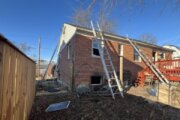United Nations agencies have long warned that it could take decades to rebuild Gaza after Israel’s offensive against Hamas, one of the deadliest and most destructive military campaigns since World War II.
Now, more than a year into the war, a new report speaks in terms of centuries.
The U.N. Conference on Trade and Development said in a report released Monday that if the war ends tomorrow and Gaza returns to the status quo before Hamas’ Oct. 7, 2023, attack on Israel, it could take 350 years for its battered economy to return to its precarious prewar level.
Before the war, Gaza was under an Israeli and Egyptian blockade imposed after Hamas seized power in 2007. Four previous wars and divisions between Hamas and the Western-backed Palestinian Authority in the West Bank also took a toll on Gaza’s economy.
The current war has caused staggering destruction across the territory, with entire neighborhoods obliterated and roads and critical infrastructure in ruins. Mountains of rubble laced with decomposing bodies and unexploded ordnance would have to be cleared before rebuilding could begin.
“Once a ceasefire is reached, a return to the pre-October 2023 status quo would not put Gaza on the path needed for recovery and sustainable development,” the report said. “If the 2007–2022 growth trend returns, with an average growth rate of 0.4 percent, it will take Gaza 350 years just to restore the GDP levels of 2022.”
Even then, GDP per capita would decline “continuously and precipitously” as the population grows, it said.
Israel says the blockade is needed to prevent Hamas from importing arms and blames the militant group for Gaza’s plight. “There is no future for the people of Gaza as long as their people continue to be occupied by Hamas,” Israel’s ambassador to the U.N., Danny Danon, said in response to the report.
350 years is more of a calculation than a prediction
Three hundred and fifty years is a long time. It would be as though England and the Netherlands were only now recovering from the wars they fought against each other in the late 1600s.
Rami Alazzeh, author of the report, said he based the calculation on the decimation of the economy during the first seven months of the war, and how long it would take to restore it at the GDP growth rate Gaza averaged from 2007 until 2022. Gross domestic product, or GDP, is the sum total of all goods and services produced in a country or territory.
“The message is the recovery in Gaza depends on the conditions in which the recovery would happen,” he said. “We’re not saying that it will take Gaza 350 years to recover because that means that Gaza will never recover.”
At the end of January, the World Bank estimated $18.5 billion of damage — nearly the combined economic output of the West Bank and Gaza in 2022. That was before some intensely destructive Israeli ground operations, including in the southern border city of Rafah.
A U.N. assessment in September based on satellite footage found roughly a quarter of all structures in Gaza had been destroyed or severely damaged. It said around 66% of structures, including more than 227,000 housing units, had sustained at least some damage.
The Shelter Cluster, an international coalition of aid providers led by the Norwegian Refugee Council, calculated how long it would take to rebuild all the destroyed homes under what was known as the Gaza Reconstruction Mechanism. That process was established after the 2014 war to facilitate some reconstruction under heavy Israeli surveillance.
It found that under that setup, it would take 40 years to rebuild all the homes.
Even in best-case circumstances, recovery could take decades
The report says that even under the most optimistic scenario, with a projected growth rate of 10%, Gaza’s recovery would still take decades.
“Assuming no military operation, and freedom of movement of goods and people and a significant level of investment, and population growth of 2.8 percent per year, UNCTAD estimates that Gaza’s GDP per capita will return to its 2022 level by 2050,” it said.
A separate report released Tuesday by the U.N. Development Program said that with major investment and the lifting of economic restrictions, the Palestinian economy as a whole, including the West Bank, could be back on track by 2034. In the absence of both, its predictions align with those of UNCTAD.
The more positive scenarios appear unlikely.
Hamas-led militants killed some 1,200 people, mostly civilians, and abducted another 250 when they stormed into southern Israel on Oct. 7, 2023. Around 100 hostages are still inside Gaza, a third of whom are believed to be dead.
Israel’s offensive has killed over 42,000 Palestinians, according to local health officials, who don’t distinguish combatants from civilians but say more than half the dead are women and children. It has displaced around 90% of Gaza’s population of 2.3 million, forcing hundreds of thousands into squalid tent camps.
Israel is unlikely to lift the blockade as long as Hamas has a presence inside Gaza. Prime Minister Benjamin Netanyahu has said Israel will maintain open-ended security control over the territory.
Since May, Israel has controlled all of Gaza’s border crossings. U.N. agencies and humanitarian groups say they have struggled to bring in food and emergency aid because of Israeli restrictions, ongoing fighting and the breakdown of law and order inside Gaza.
There’s also no indication that international donors are willing to fund the rebuilding of Gaza as long as it remains in the grip of war or under Israeli occupation. Arab Gulf states like Saudi Arabia and the United Arab Emirates have said they will only do so if there is a pathway to a Palestinian state, something to which Netanyahu is deeply opposed.
Meanwhile, the war rages with no end in sight.
Earlier in the month, Israel launched another major operation in northern Gaza — the most heavily destroyed part of the territory — saying Hamas had regrouped there.
“Everybody now calls for a cease-fire, but people forget that once the cease-fire is done, the 2.2 million Palestinians will wake up having no homes, children having no schools, no universities, no hospitals, no roads,” Alazzeh said.
All that will take a long time to rebuild, and could prove impossible under the blockade.
“If we go back to where it was before, and we shouldn’t go back to the way it was before,” he said, “then I think it means that Gaza’s done.”
___
Follow AP’s Gaza coverage at https://apnews.com/hub/israel-hamas-war
Copyright © 2025 The Associated Press. All rights reserved. This material may not be published, broadcast, written or redistributed.







